End of Eternity
The Alphans unleash a terrifying power when they free a killer who can't be killed. How can you deal with a psychopath who is immortal? ITC summary
- Shooting script 2nd October 1974. Amendments on 4th, 7th and 8th October.
- Filmed 9th October- 23 October 1974
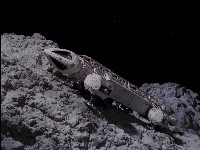

Library tracks:
- "Experiments In Space- Malus" composed by Robert Farnon (Chappell Recorded Music Library)
- "Experiments In Space- Dorado" composed by Robert Farnon (Chappell Recorded Music Library)
- "Stratosphere" composed by David Snell (Chappell Recorded Music Library)
- "Videotronics No. 3" composed by Cecil Leuter (Chappell Recorded Music Library)
- "Cosmic Sounds No. 1" composed by Georges Teperino (Chappell Recorded Music Library)
- ITC Music Cue Sheet
Robert Farnon was born 1917, and died in 2005. The Canadian composer, conductor and arranger moved to the UK after world war 2, and, like Barry Gray, settled on the island of Guernsey. Farnon worked extensively in film and television. Among his memorable theme tunes are Armchair Theatre (1956-1974), Colditz (1972-1974), and Secret Army (1978). He arranged and conducted albums for Frank Sinatra and Tony Bennett. He won four Ivor Novello Awards. His library music is also heard in The Infernal Machine, Mission Of The Darians and New Adam, New Eve.
David Snell was born in 1936 in the UK, and worked as a harpist, composer and conductor (no relation to the US film composer of the same name). He conducted the music for the films Emma (1996), The Cider House Rules (1999) and Chocolat (2000). His harp track "Stratosphere" is slowed down in this episode.
Cecil Leuter (real name Roger Roger) and Georges Teperino were French composers whose music was also used in Force of Life. Another track by Roger appears in The Infernal Machine.
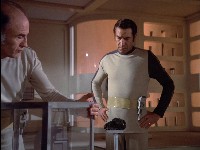
- Balor's immortality is due to accelerated cell regeneration with no time to decay (in the script it is undetectably slow except in his wounds, i.e. the speed of cell regeneration varies according to need). Many cells have a timer that limits the numbers of divisions; also each regeneration may accumulate errors in DNA replication. Some animals can regenerate limbs or tails, by growing a blastema, an amorphous mass of undifferentiated cells that migrate to the wound and specialise into functional tissues. Evidently Balor's genetic code has been reprogrammed to do the same. Electrical stimulation can aid the process of cell regeneration; note Balor also has an electric touch that he uses for torture.
- Why is there an antimatter bombarder in Koenig's office?
- After Balor is ejected from the airlock, he appears to be floating in space. Even vertically, standard atmosphere pressure would not propel a human body beyond the escape velocity of the Moon (2.4 km/second) and into space. The airlock is horizontal, level with the lunar surface. Balor might be projected for some distance over the surface (charitably we could say the episode is showing this), but he would soon crash into the lunar soil. Would the vacuum kill him, or merely incapacitate him like the door explosion (if returned to an atmosphere would he recover)?
- "We're three light years away from the nearest star system. If the asteroid's come from there, to get this far at its present velocity, it's been travelling in space for at least a thousand years." Balor's asteroid and the Moon must share a common motion through space (the asteroid
appears motionless in the Alphan sky and its position changes little during
the course of the episode). Paul's comment also suggests this trajectory traces back to the vicinity of
the nearest star system, three light years away. Three light years in over 1000 years
translates to a velocity of ~900km/s, i.e. ~0.5 lunar radii per second. Obviously, the Moon must
have encountered a "space warp" or black hole to get there before the episode begins, and
another before the next episode. Thanks to Marcus Lindroos.
- If the Moon and asteroid are in deep interstellar space "three light years
away from the nearest star system", they should be in total darkness! A supernova or bright star cluster 5-10 light years away might perhaps do the trick, though. Thanks to Marcus Lindroos.

2 fatalities, Mike Baxter, Orderly.
- The nurse attacked by Balor (actress Judith Hepburn) reappears in later episodes. Helena's dialogue suggests she is killed ("One of our orderlies... Balor a cold blooded killer!") but perhaps she is not.
Alpha Technology:
Unnumbered initial Eagle and laser Eagle
None
Aliens:
Balor from Progron. Humanoid.
Props:
Note the Apollo 9 mission posters in Baxter's room
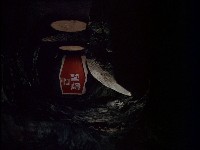
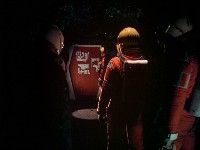
The first shot of the interior cave door is upside down. The next shot, when the actors enter, is obviously correct!
- In the caves, Koenig says to Mike Baxter (actor Jim Smilie) "Excuse me, Jim"
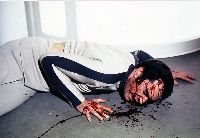
On screen, we don't see much blood when Koenig was attacked, but publicity photos reveal the make-up.
- Balor is named after Balor of the Evil Eye, a vengeful Celtic king with one eye. Byrne also attributes the name's origin to Baal, an ancient near Eastern fertility deity and king of the gods. Baal was god of life and fertility, locked in mortal combat with Mot, god of death and sterility, over 7 year cycles. From Canaan (Palestine) his worship spread to Carthage and Egypt, being popular from the 14th century BC on. The Greeks in the 6th century BC called him Belos, identifying him with Zeus, king of the Olympian gods. The Jews were strongly hostile to his worship (see Kings 18) especially from the 9th century BC when Jezebel, wife of Ahab, king of Israel, attempted to introduce worship of Baal, prompting Elijah to violent opposition. Hence the modern association of Baal with the devil.
- Note the camera focuses on faces. The action is stylised; no punching, instead Balor lifts and tosses his opponents away, or uses his electric touch. Many elements from Gothic horror: Balor's black robes; the image of his glove dashed with blood stirring in the cave rubble, approaching the woman and touching her neck, like a vampire.
- Victor says "He could have given us immortality". But he wants them mortal so they will fear death (he failed on Progron because they were immortal). In the ITC synopses and EC Tubb's novelisation, he will give them immortality, which does not make as much sense. People who cannot die have no release from torture.
- How far can Balor bring back people from the dead? Perhaps they still have to be alive in order to be revived. Koenig says he "thrashed me within an inch of my life", and Balor says he "has to be careful with mortals", implying that if they die, they cannot be revived. But perhaps he brings the nurse he kills back to life (as she is alive and well in later episodes). Resurrection by William Latham has Balor bringing Baxter back to life. Thanks to Richard Bendell.
- A number of unused scenes appear in the This Episode sequence.
- Peter Bowles: "It ended up with a lady from America getting into my house, because she wanted to be my sex slave. She sold everything and had come over because she wanted to be dominated by the most evil man in the universe." (radio interview with BBC Hereford and Worcester's Tony Fisher, 2nd April 2007). The full story is recounted in his autobiography, Ask Me If I'm Happy (2010), pages 420-422.
- "A good story idea, marred by bad casting in the main guest spot. (The artiste in question was very competent, but wrong for the part.)" 2/5 Critical Commentary by Johnny Byrne (1975)
External Links
![]() Year 1 - Episode 16
Year 1 - Episode 16 ![]()




